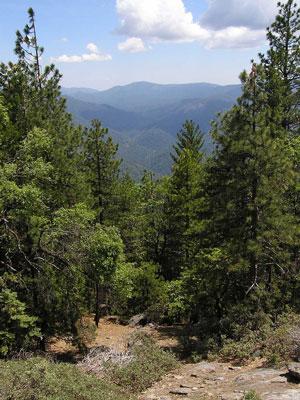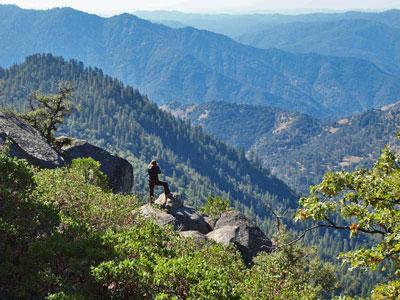Over a century ago, John Muir's vision for Yosemite National Park included areas that were not included in the present park. Now there's bipartisan support for efforts to add about 1,500 acres adjoining the western side of Yosemite to protect the area from development.
Bills to adjust the park's boundary have been introduced in both the House and Senate, and the idea has drawn support from the California State Senate, the Mariposa County Board of Supervisors, other state elected officials and numerous conservation groups.
The land is located along Yosemite's western border, about 11 miles southwest of Glacier Point, and surrounds the existing Yosemite West Subdivision, which is not included in the proposed park expansion. You can download a map depicting the proposed addition to the park at this link.
Current Owners Are Willing Sellers
About half of the land in question is owned by the Pacific Forest Trust, which acquired it in 2004 to protect it from development, holding it trust until it could be conveyed to the Park. The remaining acreage is owned by a group of private investors, and they are also willing to sell their property to the park.
If the property remains in private hands, additional expansion of residential construction on at least part of the land seems inevitable. It might come as a bit of a surprise for Republicans in the California Senate to favor park ownership rather than private development of the area, but there are sound reasons for them to do so.
Park Expansion Supported by California State Senate
On April 18, California State Senator Tom Berryhill (R-Twain Harte) "announced the passage of Senate Joint Resolution 5 (SJR 5), urging the Federal Government to pass legislation to expand Yosemite National Park."
'Today the Senate expressed its support for Yosemite National Park with the unanimous approval of SJR 5," Berryhill said. "Yosemite National Park is one of the crown jewels in our National Parks System. For those of us that live in its shadow, it is a not only a source of great pride, it also means jobs,' said Berryhill. 'Adding this 1,600-acre area to the Park is the right thing to do, both for the integrity of the Park and Sierra National Forest, as well as to protect the interests and finances of Mariposa County.'
So, how would this limited park expansion "protect the interests and finances of Mariposa County'? A key part of the answer is found in this statement from the county's governing body.
County Officials Favor Preservation Over Development for This Acreage
"The Mariposa County Board of Supervisors supports the Yosemite National Park boundary line adjustment'¦Including these parcels in the modified YNP boundaries will increase overall park preservation and reduces the threat of substantial development in a remote area that is extremely difficult for the County to provide adequate services (snow removal, public safety, etc.)"
That position is consistent with conversations I've had with local officials in other parts of the country, who point out that the tax revenue from residential development is not usually adequate to offset the costs of government services provided, especially if the homes are in remote areas. The minutes of a recent meeting concerning the Yosemite West Maintenance District highlighted those challenges for the existing development in the area.
California State Assembly Member Kristin Olsen (R ' Modesto) also added her support. "I'm very pleased to see that this legislation allowing willing sellers to add key lands to Yosemite National Park has been reintroduced. This proposal has broad bi-partisan support here in California, and I hope that it finds the same support and ultimately success in Congress. It would be fitting to add this area to the Park in time for next year's 150th anniversary celebration of the original Yosemite Grant."
Park Boundary Adjustment Requires Congressional Action
In a statement announcing her introduction of the Yosemite National Park Boundary Expansion Act of 2013, Senator Diane Feinstein (D-Calif) explained some of the reasons for her support, and answered a couple of key questions about the proposal.
"... Yosemite's popularity is also its greatest challenge. New development in Yosemite West would increase the threat of fire, habitat fragmentation and degradation of creeks that flow into the park. Conservation efforts led by the Pacific Forest Trust have protected 800 acres west of the park, but the park's boundary must be adjusted [by Congress] to allow the National Park Service to acquire these adjacent lands."
'It's important to note that ownership of private inholdings within the proposed boundary line adjustment area will not be affected in any way, and would only become part of Yosemite National Park upon voluntary sale, donation or exchange by the landowners," Feinstein said.
Senators Stress Private Property Rights Will Be Protected
Senator Barbara Boxer (D-California) is a co-sponsor of the bill, and she clarified the status of private land in the area. "In addition to protecting the right of private landowners whose land falls within the new boundary line, the bill also does not commit the federal government to purchase private inholdings, but would allow such acquisitions if Congress appropriates funds for that purpose in the future."
A companion bill has been introduced in the House by Representative Jim Costa (D-Calif). 'Yosemite is a national treasure and preserving these lands will help maintain the integrity of the park for generations to come,' said Costa.'Yosemite holds a special place in the hearts of all Californians, and that's why we have had broad bipartisan support line up behind this proposal. As we approach Yosemite's 150th anniversary, there is no more fitting tribute than recommitting ourselves to protecting the park and restoring it to John Muir's original vision.'

The proposed addition includes both nice scenery and valuable wildlife habitat. Photo from Pacific Forest Trust.
Will Republicans in the House Get On Board?
Despite the bipartisan support, the biggest hurdle for supporters may come in the Republican-controlled House, where there's been opposition to expanding the National Park Service, especially in times of tight budgets.
While there may be some validity to the argument that the NPS can't afford new parks, supporters of this measure point out that this small addition of undeveloped land to Yosemite will add very little to the park's operating costs.
A unknown in the equation so far is Representative Tom McClintock (R-Calif). A redrawing of California's congressional district boundaries last year placed Yosemite within his bailiwick, and he has not yet taken a position on the bill.
A Two-Stage Process
As is typical for such park boundary adjustment measures, the current bills authorize the boundary change and the acquisition of the described land "by donation, purchase from a willing seller with donated or appropriated funds, or exchange." The legislation does not address the question of a source of funding for those purchases, which would normally be through competition for dollars from the Land and Water Conservation Fund.
Part of the acquisition process has been eased somewhat by previous work by the non-profit group Pacific Forest Trust. Kim Kowalski, Communications Director for the Trust, told the Traveler that "the Trust purchased about 1,000 acres of the proposed 1,600 with the intention of protecting it from development and the hope of eventually transferring it to the Park."
"The total acreage of the boundary line adjustment is nearly twice the size of New York City's Central Park," Kowalski notes, and "conserving this property would also create some crucial links for recreational trails in the area."
A briefing statement from the Trust outlines advantages of the addition to the park. In addition to the previously mentioned saving of costs of providing country services for additional development, the acquisition would preserve important wildlife habitat and migration routes, reduce the risk of fire incidence for the park, counties and the Forest Service, and preserve the headwaters of Indian and Zip creeks, which flow into the main stem and the south fork of the Merced River, a National Wild and Scenic River.
Trust President Laurie Wayburn says the property "has a magnificent view of the Wild and Scenic Merced River....This was always meant to be a part of the park."
Is this an idea whose time has finally come? It's a least a little closer to fruition than it was in the lifetime of John Muir.




Comments
This proposal has effectively been smothered by Reps. McClintock (Yosemite area) and Bishop of Utah. Their new bill, HR 5397 (Aug. 1, 2014), requires that 1) first 1,575 acres of federal land must be sold, 2) the current owners of the two Yosemite parcels must donate their land to the Park, and 3) prohibits acquisition by eminent domain (in such cases the Fifth Amendment requires that "just compensation" be paid).
Although this sounds like a win/win I am greatly oposed to aquiring land through the use of eminent domain. I've seen it abused too many times. In this instance it doesn't sound like that would even be an issue.